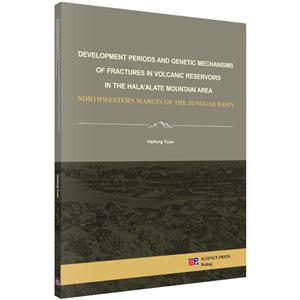扫一扫
关注中图网
官方微博
本类五星书更多>
-
>
宇宙、量子和人类心灵
-
>
(精)BBC地球故事系列-星际旅行
-
>
从一到无穷大
-
>
图说相对论(32开平装)
-
>
一本有趣又有料的化学书
-
>
刘薰宇的数学三书:原来数学可以这样学全3册
-
>
光学零件制造工艺学
准噶尔盆地西北缘哈山地区火山岩储层发育期次及成因机制(英文版) 版权信息
- ISBN:9787030495778
- 条形码:9787030495778 ; 978-7-03-049577-8
- 装帧:暂无
- 册数:暂无
- 重量:暂无
- 所属分类:>>
准噶尔盆地西北缘哈山地区火山岩储层发育期次及成因机制(英文版) 内容简介
通过录井资料和岩心观察,研究分析裂缝发育的特征,产状、裂缝的密度、宽度、充填情况、充填物的特征等;通过显微薄片观察,研究显微镜下裂缝的发育特征,如裂缝的充填物特征、裂缝的宽度等;将观察和统计结果和常规测井曲线和成像测井成果相对应,分析了不同类型裂缝的测井响应特征;通过岩心观察和显微薄片观察,分析裂缝的充填情况和充填物类型、充填次序,建立各裂缝充填物的相对时序关系;对裂缝充填物进行Sr、C、O稳定同位素分析技术,以及包裹体分析测试技术,分析各充填物的地球化学特征;对不同裂缝发育段的选取具有代表性的样品,分析其岩石力学特征,研究裂缝形成的机理;与区内地质背景相结合,分析裂缝形成的构造背景、其形成与岩性、矿物组成的关系、裂缝与层厚的关系、裂缝与岩性组合和岩性变化之间的关系,从而总结分析裂缝的发育机理。
准噶尔盆地西北缘哈山地区火山岩储层发育期次及成因机制(英文版) 目录
Contents
Chapter 1 Regional Geological Setting 1
1.1 Geological setting of the Junggar Basin 1
1.1.1 Overview of the basin 1
1.1.2 Structural evolution and structural unit division 2
1.2 Geological setting of the northwestern margin of the Junggar Basin 4
1.2.1 Geological setting 4
1.2.2 Structural evolution 6
Chapter 2 Reservoir Petrological Characteristics and Reservoir Space Types 10
2.1 Reservoir petrology 10
2.1.1 Volcanic breccia 10
2.1.2 Andesite 13
2.1.3 Basalt 15
2.1.4 Tuff 16
2.1.5 Clastic rock 17
2.2 Reservoir space types 19
2.2.1 Primary reservoir space 20
2.2.2 Secondary reservoir space 23
2.3 Factors influencing reservoir space development 27
2.3.1 Effect of lithology and lithofacies 27
2.3.2 Effect of dissolution 31
2.3.3 Effect of tectonic activity 32
Chapter 3 Oil-source Correlation and Migration Pathway Tracing 34
3.1 Geochemistry of source rocks 35
3.1.1 Evaluation criterion of source rocks 35
3.1.2 Evaluation of source rocks 36
3.1.3 Biomarkers of source rocks 42
3.2 Geochemical features of crude oil and oil-source correlation 45
3.2.1 Physical properties of crude oil 45
3.2.2 Geochemical features of crude oil and oil-source analysis 45
3.3 Migration pathways and tracing of crude oil 51
3.3.1 Conducting system of crude oil 51
3.3.2 Tracing of crude oil migration pathways 55
Chapter 4 Development Features of Reservoir Fractures 59
4.1 Development features of core fractures 59
4.1.1 Identification and statistic of fractures in coring sections 60
4.1.2 Filling features of fractures in coring sections 61
4.2 Imaging log responses of fractures 62
4.2.1 Imaging logging response of typical drilling fractures 65
4.2.2 High-conductivity fractures and high-resistivity fractures 77
Chapter 5 Geochemistry of Fracture Fillings 87
5.1 Isotope geochemistry 87
5.1.1 Sr isotope 87
5.1.2 C and O isotopes 93
5.2 Fluid inclusion geochemistry 99
5.2.1 Inclusion petrography 100
5.2.2 Fluorescence characteristics 103
5.2.3 Homogenization temperature 105
Chapter 6 Mechanical Properties of Reservoir Rocks 107
6.1 Rock mechanics characteristics 108
6.1.1 Sample information and test 108
6.1.2 Sample test procedure and results 110
6.1.3 Rock deformation characteristics 112
6.1.4 Rock mechanics parameters 117
6.2 Factors affecting mechanical properties of rock 119
6.2.1 Influence of rock types on mechanical properties 120
6.2.2 Influence of pre-existing weak planes on mechanical properties of rock 121
6.2.3 Influence of confining pressure on mechanical properties of rock 122
Chapter 7 Factors Affecting Fracture Development and Effectiveness 124
7.1 Factors affecting fracture development 124
7.1.1 Influence of lithology 124
7.1.2 Influence of formation thickness 126
7.1.3 Influence of structural position 126
7.2 Development stages of fractures 128
7.2.1 Sequence of fracture development 128
7.2.2 Tectonic evolution and fracture development stage 141
7.3 Fracture effectiveness and distribution 144
7.3.1 Analysis on fracture effectiveness 144
7.3.2 Distribution of effective fractures 147
References 151
Chapter 1 Regional Geological Setting 1
1.1 Geological setting of the Junggar Basin 1
1.1.1 Overview of the basin 1
1.1.2 Structural evolution and structural unit division 2
1.2 Geological setting of the northwestern margin of the Junggar Basin 4
1.2.1 Geological setting 4
1.2.2 Structural evolution 6
Chapter 2 Reservoir Petrological Characteristics and Reservoir Space Types 10
2.1 Reservoir petrology 10
2.1.1 Volcanic breccia 10
2.1.2 Andesite 13
2.1.3 Basalt 15
2.1.4 Tuff 16
2.1.5 Clastic rock 17
2.2 Reservoir space types 19
2.2.1 Primary reservoir space 20
2.2.2 Secondary reservoir space 23
2.3 Factors influencing reservoir space development 27
2.3.1 Effect of lithology and lithofacies 27
2.3.2 Effect of dissolution 31
2.3.3 Effect of tectonic activity 32
Chapter 3 Oil-source Correlation and Migration Pathway Tracing 34
3.1 Geochemistry of source rocks 35
3.1.1 Evaluation criterion of source rocks 35
3.1.2 Evaluation of source rocks 36
3.1.3 Biomarkers of source rocks 42
3.2 Geochemical features of crude oil and oil-source correlation 45
3.2.1 Physical properties of crude oil 45
3.2.2 Geochemical features of crude oil and oil-source analysis 45
3.3 Migration pathways and tracing of crude oil 51
3.3.1 Conducting system of crude oil 51
3.3.2 Tracing of crude oil migration pathways 55
Chapter 4 Development Features of Reservoir Fractures 59
4.1 Development features of core fractures 59
4.1.1 Identification and statistic of fractures in coring sections 60
4.1.2 Filling features of fractures in coring sections 61
4.2 Imaging log responses of fractures 62
4.2.1 Imaging logging response of typical drilling fractures 65
4.2.2 High-conductivity fractures and high-resistivity fractures 77
Chapter 5 Geochemistry of Fracture Fillings 87
5.1 Isotope geochemistry 87
5.1.1 Sr isotope 87
5.1.2 C and O isotopes 93
5.2 Fluid inclusion geochemistry 99
5.2.1 Inclusion petrography 100
5.2.2 Fluorescence characteristics 103
5.2.3 Homogenization temperature 105
Chapter 6 Mechanical Properties of Reservoir Rocks 107
6.1 Rock mechanics characteristics 108
6.1.1 Sample information and test 108
6.1.2 Sample test procedure and results 110
6.1.3 Rock deformation characteristics 112
6.1.4 Rock mechanics parameters 117
6.2 Factors affecting mechanical properties of rock 119
6.2.1 Influence of rock types on mechanical properties 120
6.2.2 Influence of pre-existing weak planes on mechanical properties of rock 121
6.2.3 Influence of confining pressure on mechanical properties of rock 122
Chapter 7 Factors Affecting Fracture Development and Effectiveness 124
7.1 Factors affecting fracture development 124
7.1.1 Influence of lithology 124
7.1.2 Influence of formation thickness 126
7.1.3 Influence of structural position 126
7.2 Development stages of fractures 128
7.2.1 Sequence of fracture development 128
7.2.2 Tectonic evolution and fracture development stage 141
7.3 Fracture effectiveness and distribution 144
7.3.1 Analysis on fracture effectiveness 144
7.3.2 Distribution of effective fractures 147
References 151
展开全部
书友推荐
- >
二体千字文
二体千字文
¥16.0¥40.0 - >
龙榆生:词曲概论/大家小书
龙榆生:词曲概论/大家小书
¥9.1¥24.0 - >
新文学天穹两巨星--鲁迅与胡适/红烛学术丛书(红烛学术丛书)
新文学天穹两巨星--鲁迅与胡适/红烛学术丛书(红烛学术丛书)
¥9.9¥23.0 - >
小考拉的故事-套装共3册
小考拉的故事-套装共3册
¥35.4¥68.0 - >
唐代进士录
唐代进士录
¥18.7¥39.8 - >
朝闻道
朝闻道
¥9.0¥23.8 - >
李白与唐代文化
李白与唐代文化
¥9.9¥29.8 - >
我与地坛
我与地坛
¥16.8¥28.0
本类畅销
-
1:3000000中国及邻区盆地火成岩油气地质图
¥478.4¥598 -
碳酸盐岩沉积学
¥17.2¥40 -
环境地质学
¥9.5¥22 -
2022图书×抽奖盲袋
¥9.9¥25 -
2023读书月阅读盲盒——天黑,闭眼,刀谁?
¥42.3¥158















